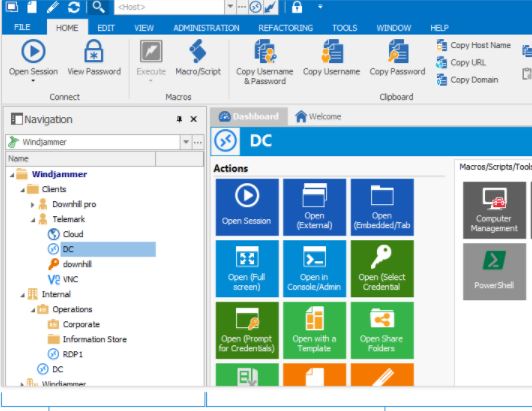- Install Terminal Services Manager Xp
- Terminal Services Manager Windows 10 Pro
- Terminal Services Manager Windows 10 Online
Last updated on February 27th, 2020

This article contains step by step instructions on how to install and configure the Remote Desktop Services on a Windows Server 2016 or 2012. In Windows Server 2016 & 2012 the Terminal Services role has been replaced by the Remote Desktop Session Host (RDSH) role service and is part of Remote Desktop Services (RDS). A Remote Desktop Session Host (RDSH) server, provides to remote users the ability to access the applications on the RDS host server and the company resources from anywhere by using an RDP client.
In this tutorial you 'll learn how to setup and configure a Windows Server 2016 or 2012 as a Remote Desktop Session Host (Terminal) server, in order to provide remote desktop sessions, based on the number of Remote Desktop Services client access licenses (RDS CALs) installed on the RDSH server.
Download PuTTY Manager for free. Tabbed PuTTY Interface! Features: A tabbed interface and dockable windows, Fullscreen mode, Working with existing PuTTY binary, or allow you to download it directly from the official page, Let’s you export/import PuTTY connections to single file, Download it for free for any use! This is one of the first services I disable on a new Windows 10 PC to strengthen the privacy of the user. Downloaded Maps Manager. Display Name: Downloaded Maps Manager Command: C: WINDOWS System32 svchost.exe -k NetworkService -p Default Startup: Automatic (Delayed Start) Dependencies: DCOM Server Process Launcher, RPC Endpoint Mapper. Terminal Services Manager Terminal Services Manager is a comprehensive tool for managing Windows 2000 Terminal Services. This tool is capable of controlling virtually all aspects of Terminal Services.
How to Setup and Configure a Windows Server 2016/2012 as a Remote Desktop Session Host Server (Terminal Server).
Notes:
1. The mentioned steps below, can be applied either on a Domain Controller or in a standalone server 2016/2012.
2. If the Terminal services are installed on a server that will act as a Domain Controller also, then first install the Active Directory Domain Service (AD DS) role service and promote the Server to a Domain Controller, before installing the Remote Desktop Session Host (RDSH) role service (Terminal Service).
3. Keep in mind that the below configuration does provide access to RemoteApp programs or the RDWeb site, because the Remote Desktop Connection Broker role service will not be installed.
Step 1. Install Remote Desktop Services on Server 2016/2012.
Step 2. Activate the Remote Desktop License Server.
Step 3. Install Licenses on the Remote Desktop License Server.
Step 4. Configure RD Session Host role to use the local Remote Desktop Licensing server & Set the Remote Desktop licensing mode.
Step 5. Add RD Clients (Users) to the Remote Desktop Users Group.

Step 6. Allow the log on through remote desktop Services.
Step 1. Install Remote Desktop Licensing and Remote Desktop Session Host role services.
1. Open 'Server Manager' and click on Add Roles and Features.
2. At the first screen of 'Add Roles and Features wizard' leave the Role-based or feature-based installation option and click Next.
3. At the next screen, leave the default option 'Select server from the server pool' and click Next.
4. Select the Remote Desktop Services and click Next.
5. Leave the default settings and click Next at Features and Remote Desktop Services screens.
6. At Role Services screen, select the Remote Desktop Licensing role service and then click Add Features.
7. Then select the Remote Desktop Session Host role service and click Add Features again.
8. When done, click Next to continue.
9. Finally click Install to install the Remote Desktop Services: Remote Desktop Licensing and Remote Desktop Session Host.
10. When the installation is completed close the 'Add Roles and Features Wizard' and restart your server.
Step 2. Activate the Remote Desktop License Server.
1. Simultaneously press the Windows + R keys to open run command box.
2. Type licmgr.exe and press Enter to open the RD Licensing Manager *
* Note: Alternately, you can launch the RD Licensing Manager, from Control Panel –> Administrative Tools –> Remote Desktop Services –> Remote Desktop Licensing Manager.
3. At the right pane, right click on the server name and select Activate Server.
4. Click Next at the Welcome screen and then click Next again at Connection method options.
5. At 'Company Information' window, fill the required fields and click Next twice to activate your License Server.
6. When the activation is completed, leave checked the 'Start Install Licenses Wizard' checkbox and click Next.
7. Continue to next step.
Step 3. Install Licenses on the Remote Desktop License Server.
1. At 'Welcome to the install licenses wizard', click Next
2. On the License Program page, select the appropriate program through which you purchased your RDS CALs, and then click Next.
3. According the License Program you selected on the previous page, type either the license code or the agreement number provided when you purchased your RDS CALs and then click Next.
4. On the Product Version and License Type page, select the appropriate product version, license type, and the quantity of the RDS CALs based on your RDS CAL purchase agreement, and then click Next.
5. When the RDS CALs installed on the server, click Finish. *
TIP: If you cannot activate the RDS Server automatically, then try to activate it using the Web Browser or via Telephone. To do that:
a. Right-click on the Server's name and select Properties.
b. Change the Connection Method to Web Browser or to Telephone.When done, click OK.
c. Finally, right click on the server name, select Activate Server and follow the onscreen instructions to completed the activation.
Install Terminal Services Manager Xp
Step 4. Configure RD Session Host role to use the local Remote Desktop Licensing server & Set the Remote Desktop licensing mode.
1. Open Group Policy Editor. To do that:
1. Simultaneously press the Windows + R keys to open run command box.
2. Type gpedit.msc and press Enter.
2. In Group Policy Editor navigate to:
- Computer ConfigurationAdministrative TemplatesWindows ComponentsRemote Desktop ServicesRemote Desktop Session Host Licensing
3. At the right pane, double click at Use the specified Remote License Servers.
4. Click Enabled, and then at 'License server to use' field, type the RDS license server name and click OK.
5. Then open the Set the Remote Desktop licensing mode setting.
6. Click Enabled and then specify the licensing mode (Per User or Per Device) for the RDS host server and then click OK again.
7.Close Group Policy Editor.
8. Verify the RD Licensing configuration, by going to: Windows Control Panel –> Administrative Tools –> Remote Desktop Services –> RD Licensing Diagnoser.
Step 5. Add RD Clients (Users) to the Remote Desktop Users Group.
1. Open Server Manager.
2. From Tools menu, select Active Directory Users and Computers. *
* Note: If the RD Session Host Service is not installed on the Domain Controller, use the 'Local Users and Groups' snap-in or the 'Remote' tab in the 'System Properties' on the RDS host server, to add the remote desktop users.
3. Double click at your domain on the left and then select Builtin.
4. Open Remote Desktop Users on the right pane.

Terminal Services Manager Windows 10 Pro
5. At Members tab, click Add.
6. Type the name(s) of the users that you want to give Remote access to the RDS Server and click OK.
7. After selecting the remote desktop users, click OK again to close the window.
8. Continue to step-6 below.
Step 6. Allow the log on through remote desktop Services.
1. Open the Local Group Policy Editor. To do that:
1. Simultaneously press the Windows + R keys to open run command box.
2. Type gpedit.msc and press Enter.
2. In Group Policy Editor navigate to: Computer Configuration > Windows Settings > Security Settings > Local Policies > User Rights Assignment.
3. At the right Pane: double click at Allow log on through Remote Desktop Services.
4. Click Add User or Group.
5. Click Object Types, check all the available objects (Users, Groups, & Built-in security principals) and then click OK.
6. Type remote desktop users and then click OK.
7. Finally click OK again and close Group Policy Editor.
8. Now you 're ready to connect to the Remote Desktop Session Host Server 2016/2012 from any Remote desktop client.
That’s it! Let me know if this guide has helped you by leaving your comment about your experience. Please like and share this guide to help others.
We're hiring
We're looking for part-time or full-time technical writers to join our team! It's about a remote position that qualified tech writers from anywhere in the world can apply. Click here for more details.
Full household PC Protection - Protect up to 3 PCs with NEW Malwarebytes Anti-Malware Premium!
Pardon our french.... The latest version LizardSystems software
You can download evaluation versions of our products and try them for free. You can also download these files if you would like to upgrade your product to the latest version. To download a product, click on a button in the Link column.
Terminal Services Manager
Helps you monitor and manage the usage of host resources by remote users.
- Evaluation period: 30 days
- Fully functional during the evaluation period
- Supported OS: Windows 8, 8.1, 2012, 2012R2, 10, 2016, 2019
Remote Process Explorer
Powerful tool for managing, monitoring and analysing processes on a local or remote computer.
- Evaluation period: 30 days
- Fully functional during the evaluation period
- Supported OS: Windows 8, 8.1, 2012, 2012R2, 10, 2016, 2019
Remote Desktop Audit
Monitoring and analyzing Remote Desktop Services logs.
- Evaluation period: 30 days
- Fully functional during the evaluation period
- Supported OS: Windows 8, 8.1, 2012, 2012R2, 10, 2016, 2019
Wi-Fi Scanner
Simple and convenient tool for monitoring 802.11a/b/g/n/ac/ax wireless networks.
Terminal Services Manager Windows 10 Online
- Evaluation period: 10 days
- Fully functional during the evaluation period
- Supported OS: Windows 8, 8.1, 2012, 2012R2, 10, 2016, 2019
Network Scanner
IP scanner for network analysis that will allow you to see all network computers in several seconds.
- Evaluation period: 10 days
- Fully functional during the evaluation period
- Supported OS: Windows 7, 2008R2, 8, 8.1, 2012, 2012R2, 10, 2016
LanCalculator
IP Subnet Calculator for IPv4/IPv6 Networks
- Evaluation period: 30 days
- Fully functional during the evaluation period
- Supported OS: Windows 7, 2008R2, 8, 8.1, 2012, 2012R2, 10, 2016
Find MAC Address
Easy way to find the MAC address of a local or remote computer on the network.
- Evaluation period: 10 days
- Fully functional during the evaluation period
- Supported OS: Windows 7, 2008R2, 8, 8.1, 2012, 2012R2, 10, 2016
LanSend

Instant messaging to remote computers.
- Evaluation period: 10 days
- Fully functional during the evaluation period
- Supported OS: Windows 7, 2008R2, 8, 8.1, 2012, 2012R2, 10, 2016
Change MAC Address
Simple tool for changing the MAC address of a network adapter.
- Evaluation period: 10 days
- Fully functional during the evaluation period
- Supported OS: Windows 7, 2008R2, 8, 8.1, 2012, 2012R2, 10, 2016
During the evaluation period the software will start to remind you that it has not been licensed yet. The reminder message will, however, only be displayed once every time you start the program. If you would like to continue using the program after the evaluation period, you should register or purchase a software license.
You can register and purchase your license online at Purchase page.
